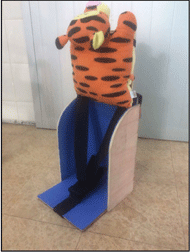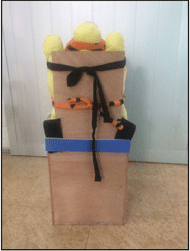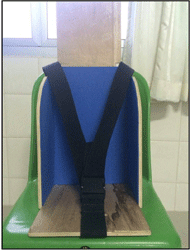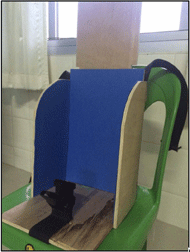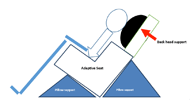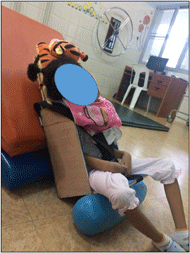Sittidech T., Kheowsri S., Traitruengsakul S., Krityakiarana W.
Department of Rehabilitation for Persons with Disability, Ratchasuda College, Mahidol University, Thailand
ABSTRACT
Assistive technology (AT) is crucial for helping children with cerebral palsy to improve their performance. This case study described the low cost adaptive seating solutions in severe motor and cognitive developmental delay of a cerebral palsy child. Often children are prescribed commercially available seating devices (such as, wheelchair) which do not always aligned with the environment and life style of child and family. Together with the cost of AT is high and some cases might not be able to support. We applied the SETT model to evaluate the need of child with cerebral palsy (and parent) and working as a multidisciplinary team to design the low cost adaptive seat. This single case study demonstrated how an assistive technology professional (ATP) working in setting optimized seating device by custom made seating device components in modifying difficult activity (seating), posture and activity daily living (ADL) in child with cerebral palsy who having deficit the motor and cognitive function. Multidisciplinary team approach, seating program training and conservative physical therapy program were effective in assisting the parent and child in meeting their functional activity needs. The results of these low cost seating solutions was evaluated by parent’ interview which presented improvement in difficult activity and social interaction.INTRODUCTION
Many children with cerebral palsy have difficulty or inability to sit independently due to moderate to severe impairment in motor and cognitive development. The severely multiply handicapped children require the knowledge and skills of Occupational Therapists and Physical therapist gain the physical performance and to adjust the environment to available for individual needs. Seating is one of the crucial key to allow the children with cerebral palsy to have the better functional activities. Therefore, adaptive seating may be the most important device available for any client who cannot be comfortably, safely and functionally seated in the wheelchair (Angsupaisal et al., 2015; Ryan, 2012; Chung et al., 2008).Evidence to date suggests that adaptive seating systems can play a major role in the positioning and support of children with disabilities such as cerebral palsy (Rodby-Bousquet, Hägglund, 2010; Stavness, 2006).
Seating adjustment might require accomplish a balance among upright anatomical position, symmetrical posture control and ability to function. From the complication of cerebral palsy pathophysiology, they require external support or fixation from the seating systems. Both support and fixation provide accommodation for compromised both postural control and improve postural deficits. The problems depicted in the literature commonly include retention of primitive reflexes, presence of structural asymmetries and abnormalities of muscle tone (Angsupaisal et al., 2015). To develop appropriate seating device the multidisciplinary rehabilitation team is extremely important to share their knowledge and experience to achieve the highest purpose. In our team (physical therapist, engineer, educational professional, parent and caregiver) worked in cooperation to design an individualized custom fabricated components of seating device. Assistive seating devices or this adaptive seating can include a range of components and it is essential that prescribing therapists understand their purpose and when they should be recommended (Ling SH, 2011).
We are encouraged the community to take part in the rehabilitation for persons with disability. Moreover, the suburb area in Thailand are composted with low income family. The high end or middle end assistive technology is limited for these group. The purpose of this case report is to modify the equipment in the community to serve the persons with disability to have better quality of life for both child with cerebral palsy and parent (or caregiver). Here we present the case of a child with cerebral palsy with severe motor and cognitive impairment. We discuss therapeutic success of the low cost adapted seat and its effectiveness through parents’ interview and evaluation of physical therapist.
CASE REPORT
A 7 years old female child with diagnosis of spastic CP and delayed development, GMFM level V with profound mental retardation reported to physical therapy department and special education for rehabilitation. Child had severe developmental delay in motor, cognitive, perceptual, emotional and social aspect. On examination child was active, responded to surrounding stimuli. Poor motor functional control of bilateral upper and lower extremities, no targeting movement and no motor milestones. Muscle tone was moderate spastic in bilateral upper and lower extremities. Primitive reflex ATNR was present abnormally. Child had not receive assistive technology to support at home. Parents expressed concern of poor posture in chair especially feeding, since this lead to the aspiration and pneumonia or infection. SETT model was used to evaluate family and child with cerebral palsy need for design the adaptive seat for child with cerebral palsy.
To achieve optimum seating position at home especially on the floor, the case was discussed with multidisciplinary specialist for possible seating components an adaptive seating in the chair and on the floor such as, lateral trunk support and neck support. First the anthropology of child with cerebral palsy was performed. Then, head support of by using high wood plate and pillow were applied to prevent posterior backward neck extension. But head in midline and upright position was not achieved (Figure 1). The limitation for anterior flexion, lateral flexion and rotation of the trunk was provided by the seat belt and lateral side-board. (Figure1). The seat was remodel to maintain in trunk alignment (Figure2). To prevent trunk lateral bending and encourage shoulder symmetrical level and well prepare for improve upper limbs function
RESULTS AND DISCUSSION
Child had a better postural alignment when using the low cost custom-made components of seating device as compared to previously. Parent interview was taken after 3 weeks of use of low cost adaptive seating which provided feedback of effectiveness of such custom made individualized design of seating device. This case study reported beneficial effects of positioning including improved, social interaction and community acceptance. Through the interview it indicated that positioning and social interaction improved but no change in eye hand activities. The average time spent sitting in low cost adaptive seating device was increased. Because the unable to control posture, Child had chance to sit more during afternoon and evening. Moreover, parent had to carry child with her all the time during work on family duties before receive the low cost adaptive seat. But more independent for parents to work and take care the child with cerebral palsy was improved. The stress in parent related to the feeding of child was also decreased.
Child with cerebral palsy had difficult functional problem of head neck control. The design of head support did not resolve this problem. The abnormal tone and asymmetrical postural control of head, trunk and both extremities were crucial course of postural control. It was effective in maintaining upright posture for child with cerebral palsy. This facilitated eye contact and visual horizontal eye contact which encouraged visual orientation in the surrounding and increased social interaction. The abnormal alignment of neck rotation might cause of ATNR, therefore, keep head position in midline to avoid neck active rotation was suggested. (Lee et al., 2016) Herman and Lange 1999). Head position can lead overall body tone, particularly in the trunk and upper limbs. (Herman and Lange, 1999; Holmes et al. 2003). These finding is related to our observation.
There are several studies presented that the abnormal tone of muscle lead to the problem of scoliosis (Angsupaisal et al., 2015; Ryan, 2012; Chung et al., 2008). This low cost adaptive seating is using only side-board to support the lateral of the body to adjust the alignment of child with cerebral palsy’s trunk. We found that the lateral side-board was supported the lateral trunk flexion. However, the more precise supporting system might be reconsider to improve the quality of this adaptive seat, such as, the pillow support direct to the lateral trunk.
REFERENCES
[1] Angsupaisal M, Maathuis CG, Hadders-Algra M. Adaptive seating systems in children with severe cerebral palsy across International Classification of Functioning, Disability and Health for Children and Youth version domains: a systematic review. Dev Med Child Neurol. 2015 Oct;57(10):919-30.
[2] Ryan SE. An overview of systematic reviews of adaptive seating interventions for children with cerebral palsy: where do we go from here? Disabil Rehabil Assist Technol. 2012 Mar;7(2):104-11.
[3] Chung J, Evans J, Lee C, Lee J, Rabbani Y, Roxborough L, Harris SR. Effectiveness of adaptive seating on sitting posture and postural control in children with cerebral palsy. Pediatr Phys Ther. 2008 Winter;20(4):303-17.
[4] Rodby-Bousquet E, Hägglund G. Sitting and standing performance in a total population of children with cerebral palsy: a cross-sectional study. BMC Musculoskelet Disord. 2010 Jun 23;11:131.
[5] Stavness C. The effect of positioning for children with cerebral palsy on upper-extremity function: a review of the evidence. Phys Occup Ther Pediatr. 2006;26(3):39-53.
[6] Ling Sui Hui. Locally made Paediatric Rehabilitation and Seating systems for Cerebral palsy children in Sarawak. International journal of Public Health Research 2011, 146-151.
[7] Lee CK, Jeon HR, Yoon DH, Kim KN, Yi S, Shin DA, Hosogane N, Cao K, Cho SR, Ha Y. Clinical Outcomes of Correcting Cervical Deformity in Cerebral Palsy Patients. World Neurosurg. 2016 Dec;96:500-509.
[8] Herman JH and Lange ML. Seating and positioning to manage spasticity after brain injury. Neurorehabilitation 1999;12(2):105-117.
[9] Saavedra S, Woollacott M, van Donkelaar P. Head stability during quiet sitting in children with cerebral palsy: effect of vision and trunk support. Exp Brain Res. 2010 Feb;201(1):13-23.
[10] Holmes, AKJ, Michael SM, Thorpe SL and Solomonidis SE. Management of scoliosis for the non-ambulant spastic cerebral palsy population – a biomechanical study. Clin Biomech (Bristol, Avon). 2003 Jul;18(6):480-487.
1;33(3):246-56.
